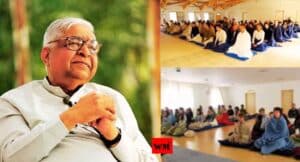{ ram mandir, ayodhya ram mandir,ram mandir ayodhya, ram janmbhoomi, ram lalla, babri masjid, ram mandir construction, ram temple ayodhya, yogi adityanath, narendra modi, ram mandir architect, ram mandir donation, ram mandir legal battle, ram mandir verdict, ram mandir opening date,ram mandir station,ayodhya ram mandir photo }
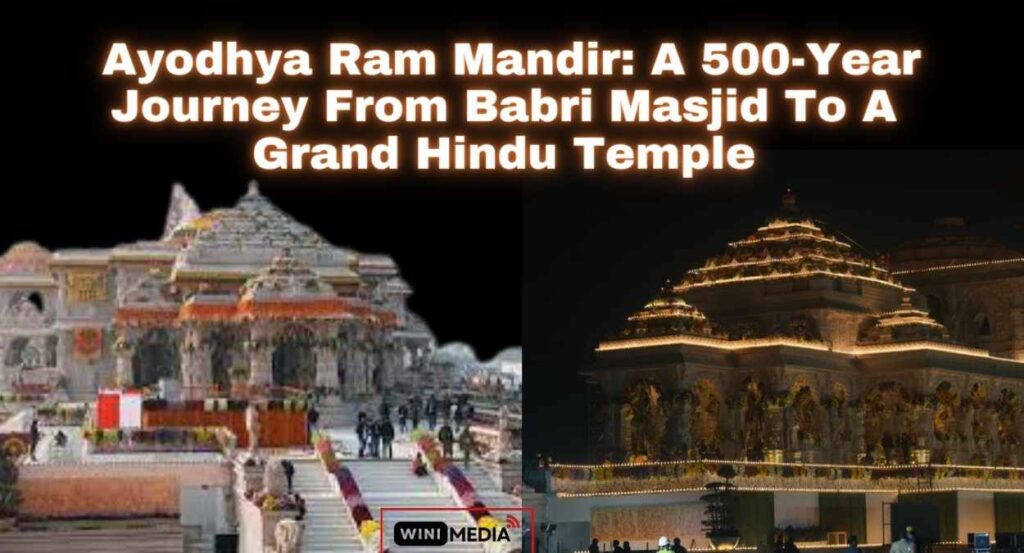
Ayodhya Ram Temple: Grand Pran Pratishtha Ceremony, A Story of 134 years of fight!
The consecration ceremony (Pran Pratishtha) of the Ram Lalla idol in the new grand Ram Mandir at Ayodhya on January 22, 2024, marked the culmination of a five-century-old dream of the Hindu community. Attended by Prime Minister Narendra Modi, RSS chief Mohan Bhagwat and other dignitaries, the once-in-a-lifetime event saw the installation of the infant Ram deity into the inner sanctum, amidst chanting of Vedic hymns and spiritual grandeur.
Many devotees including the invited more than 15000 VIP guests were present in Ayodhya and more than 100 million glued to TVs were left overwhelmed with divinity and awe as the sacred rituals concluded with a magnificent aarti. The Ram Mandir now opens as a monument of India’s culture and ethos at the site believed to be the birthplace of Lord Ram according to the Hindu faith.
This path-breaking milestone was achieved after an arduous legal battle and campaign lasting 134 years. It restored the cultural rights of India’s Hindu majority after the Mughal Era Babri Mosque was demolished at the site in 1992.
In this article we are going to trace the epic story behind Ayodhya and its new Ram Mandir, we shall explore topics like:
- The 1528 Babri Mosque construction that sparked the temple-mosque dispute
- The 1885 legal case that marked the first battle over the sacred site
- The 1949 idol installation and 1992 demolition incidents
- The protracted timeline of the legal case through various courts
- The Yogi and Modi government’s role in temple construction
- The unique architectural design planned for the grandest Hindu temple
- Importance of the Ram Mandir for Hindu ethos and identity
Let’s dive deep into the fascinating 500-year journey to rebuild Ram’s sacred temple at his claimed birthplace in the holy Ayodhya.
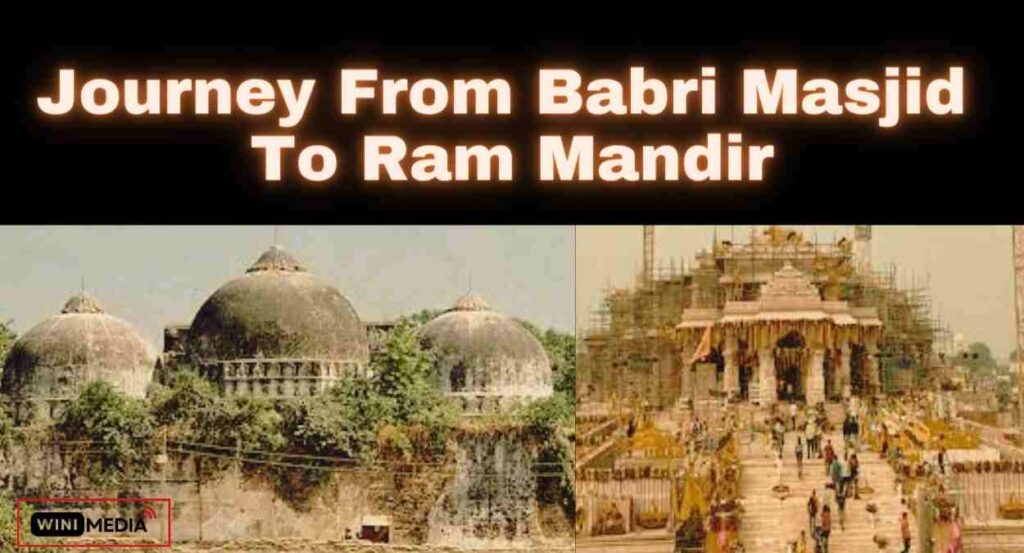
1528: Babri Masjid Built at Ram’s Birthplace, Sparking Conflict
- In 1528, Mir Baqi, a nobleman of Mughal invader Babur, constructed the Babri Masjid on the site of Ram Janmabhoomi.
- For Hindus, this mosque had been built after destroying a pre-existing Ram temple at the birthplace of Lord Ram.
- The Hindus did not protest much during Mughal rule from 1528-1853.
- After the British came to India, Hindu leaders reignited the temple campaign.
1885: First Legal Battle for Ram’s Birthplace
- In 1885, Mahant Raghubar Das filed a civil suit seeking permission to build a temple on the Ram Chabutra in the outer courtyard.
- This was the first legal attempt to reclaim the Janmasthan site after the Babri Masjid construction.
1949: Idols Placed Inside Babri Masjid
- On the night of December 22, 1949, idols of Ram and Sita were placed inside the disputed Babri Masjid structure.
- This conversion of the mosque into a makeshift temple was a turning point in the history of the dispute.
1950: First Civil Suit After Independence
- After India’s independence, two civil suits were filed in January 1950 staking claim over the site.
- One was by Paramhans Ramchandra Das and the second by Gopal Singh Visharad.
- They demanded the right to worship without obstruction at the Janmasthan.
1986: Locks of Babri Masjid Opened for Hindu Prayers
- In 1986, the district court ordered the gates of the masjid to be opened so Hindus could worship inside.
- This was a big victory for the Hindu side.
1989: Shilanyas Ceremony Performed for New Ram Temple
- In 1989, the Vishwa Hindu Parishad performed a Shilanyas or foundation-stone laying ceremony for a new temple at the site.
- This ceremony was attended by top leaders to begin temple construction.
1990: L.K. Advani’s Rath Yatra Galvanized Movement
- In 1990, BJP leader L.K. Advani carried out a 10,000 km Rath Yatra demanding the construction of a Ram Mandir.
- Advani was arrested but the yatra brought huge momentum to the temple movement.
1992: Babri Masjid Demolished, sparking Riots
- On December 6, 1992, thousands of Hindu activists demolished the Babri Masjid structure, sparking communal riots across India.
- Over 2000 lost lives in the violence that followed.
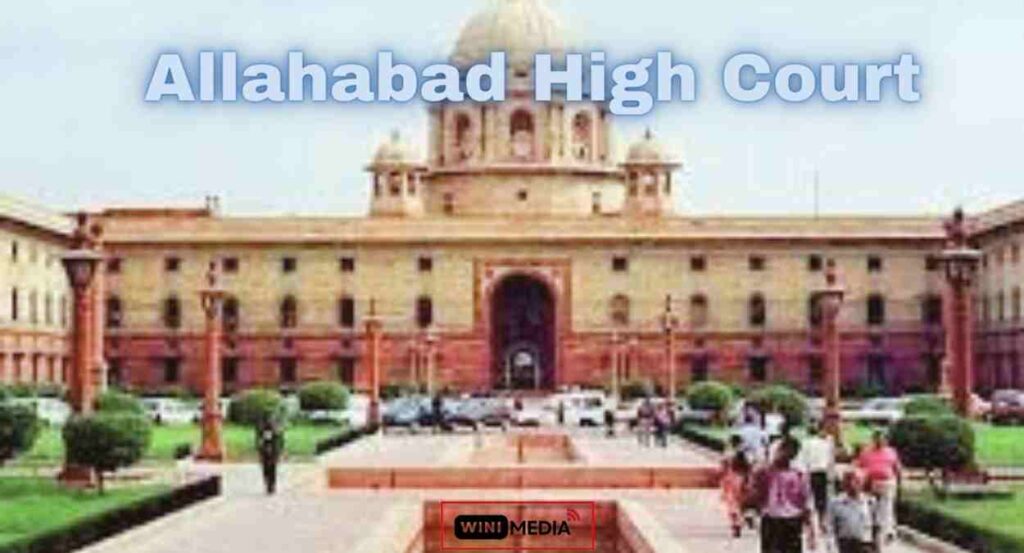
2002: Allahabad HC Begins Hearing on Title Suit
- In April 2002, the Allahabad High Court in UP began hearings on determining the legal ownership of the disputed land.
- In 2003, the ASI was asked to conduct excavations which found proof of a temple under the Masjid.
- On September 30, 2010, the Allahabad HC delivered the historic judgment dividing the land into 3 equal parts.
2019: SC Delivers Landmark Verdict in Favor of Ram Mandir
- On November 9, 2019, the Supreme Court gave the entire 2.77 acres of disputed land for temple construction to the Hindu side.
- It also ordered 5 acres of land to be given to Muslims for a new mosque.
- With this verdict, the case was resolved after 134 years of legal battles.
2020 Onwards: Grand Temple Construction Begins
- In 2020, the Ram Mandir Trust was set up by the Centre to oversee temple construction.
- On August 5, 2020, the Bhoomi Pujan was performed by PM Modi, marking the start of construction.
- The first phase was completed by January 2024, with the installation of Ram Lalla idols.
- The temple will be open to devotees from February 2024 after a grand opening ceremony.
Unique Architecture and Design of the Ram Mandir
The design of the new Ram Mandir incorporates both grand scale and intricate details depicting Indian culture:
- It has been built in the Nagara architectural style followed in north India’s ancient Hindu temples.
- The temple complex will span a vast 67 acres with 5 main mandapas and 392 pillars.
- The primary temple structure itself has three floors with a height of 161 feet.
- The temple foundation goes 49 feet deep and uses 2.7 lakh cubic feet of concrete.
- Sandstone and marble have been sourced from the best mines in India for carving and construction.
- Over 200 eminent sculptors have worked on the temple’s ornate carvings depicting legends from Hindu scriptures.
- Intricate carvings depicting flora, fauna, and spiritual figures adorn pillars, walls, and ceilings across the expansive temple.
- The main shrine houses the idol of Ram Lalla along with the deities of Sita, Lakshman and Hanuman.
The architecture strikes the perfect balance between grandeur and intricate ornamentation as per ancient Indian temples.
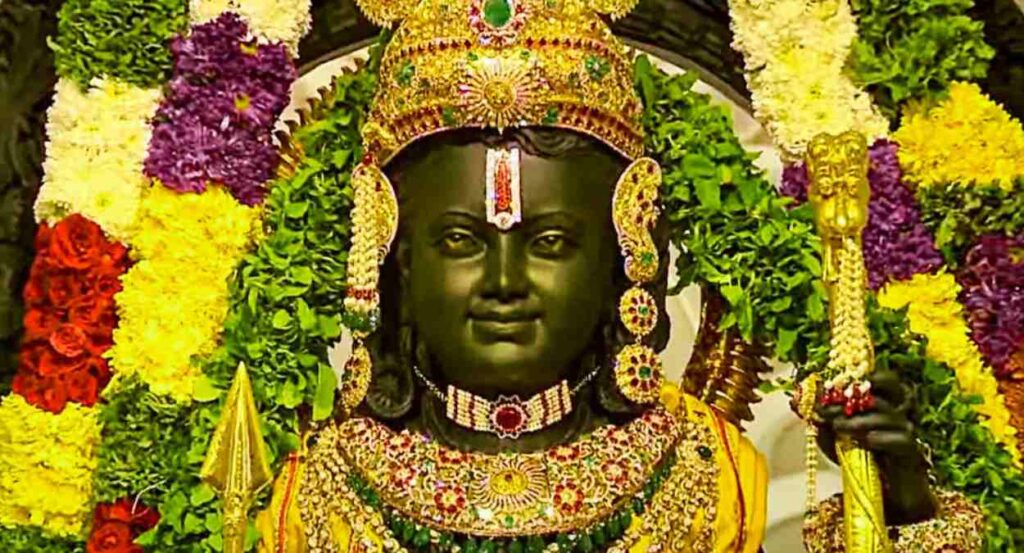
Ram Lalla Idol Design Based on Scriptural Descriptions
The idol of infant Ram (Ram Lalla) has been designed to match descriptions in ancient Hindu texts:
- It is carved out of a single black touchstone (shila) rock that retains symbolic and spiritual significance in Hinduism.
- The finely sculpted 51-inch tall idol shows Ram as a 5-year-old, reflecting innocence and radiance.
- He adorns a yellow silk dhoti, angvastram, and vanamala (garland), along with gold-plated ornaments studded with jewels on the crown, ears, neck, wrists and waist.
- The carving includes symbols like lotus feet and the 10 avatars of Vishnu to signify divinity.
- The idol was intricately carved over 6 months using advanced sculpting tools by expert sculptors.
The beautiful idol captures the serenity and aura of Lord Ram as described in the holy scriptures.
Construction Features Modern Engineering and Safety
The grand construction of the temple has blended traditional methods with modern engineering feats:
- A team of over 250 specialized engineers from leading firms like L&T, Tata Consulting Engineers, IITs and NITs was involved.
- 18 walls of the temple have been constructed using quake-proof slab columns and grid beams made of reinforced concrete and steel.
- Pressure bars have been installed under the foundation to provide stability against earthquakes and prevent damage.
- A PVD-based soil consolidation technique has been used to prevent the temple from sinking into loose soil.
- The foundation is strong enough to support the load of three Taj Mahal monuments i.e. around 13,000 tonnes.
- The mandir complex has provisions for fire safety with dedicated water tanks and underground hydrant pipelines.
Advanced engineering techniques have been used in building the temple to ensure longevity and the ability to withstand natural calamities.
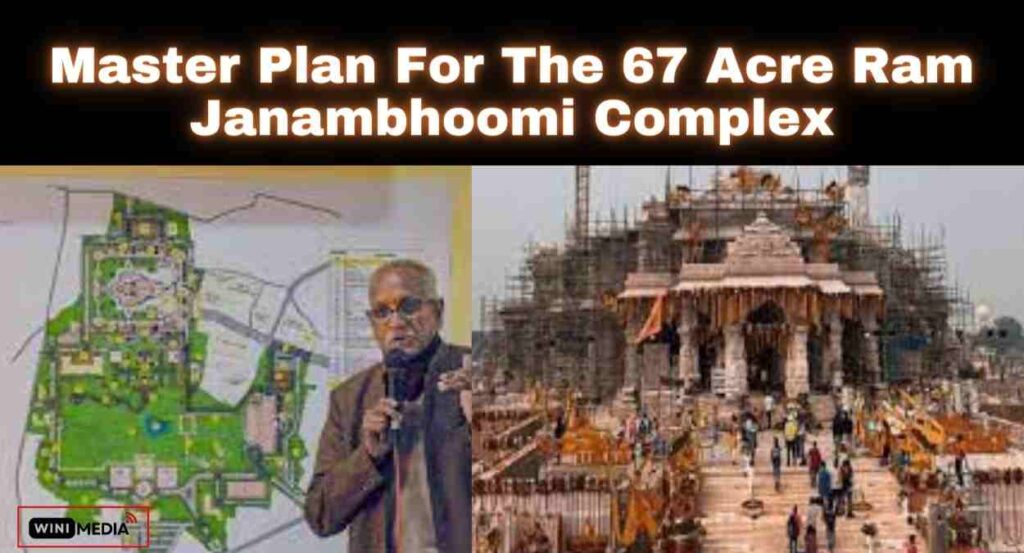
Master Plan for the 67 Acre Ram Janambhoomi Complex
The Ram Mandir is the centrepiece of a 67-acre temple complex with several other notable features:
- A new museum showcasing artefacts related to Ram and the temple movement.
- Surya Kund and Chandran Kund for ritual ablutions.
- Valmiki Ashram including statues of the sage along with Sita and Luv-Kush.
- Renovated and expanded old temples like the Kuber Mandir and Hanumangarhi.
- Gaushala, covered footpath for parikrama, a religious dining area, auditoriums etc.
- Modern visitor facilities like arrival plaza, waiting halls, drinking water, toilets, helpdesks etc.
- Security infrastructure including CCTVs, barricading, and X-ray baggage scan.
The master plan has been designed to facilitate smooth traffic flow and create an atmosphere of spirituality among pilgrims.
Importance of the Ram Mandir for the Hindu Community
The rise of the new Ram Mandir in Ayodhya carries immense significance for Hindus across the globe:
- It brings to fruition a 500-year-old dream and struggle of the Hindu community.
- It is a testament to the enduring devotion to Lord Ram across generations.
- The mandir will promote national integration and communal harmony now.
- Pilgrimages and festivals like Ram Navami will be celebrated on a grand scale now.
- The economy of Ayodhya and UP at large will benefit
- It will create lakhs of jobs during the construction and operation phases.
- Ayodhya has regained its historic status as one of the holiest pilgrimage centres of the Hindu faith.
- The mandir is expected to attract over 10 crore pilgrims every year, boosting tourism.
- It will inspire the global Hindu population about the richness of Indian art, culture and civilization.
- Ram Mandir reaffirms India’s secular Constitution which provides freedom to practice one’s religion.
The grand Ram Mandir will usher in a new era for Sanatan Dharma and Hindu identity across the globe.
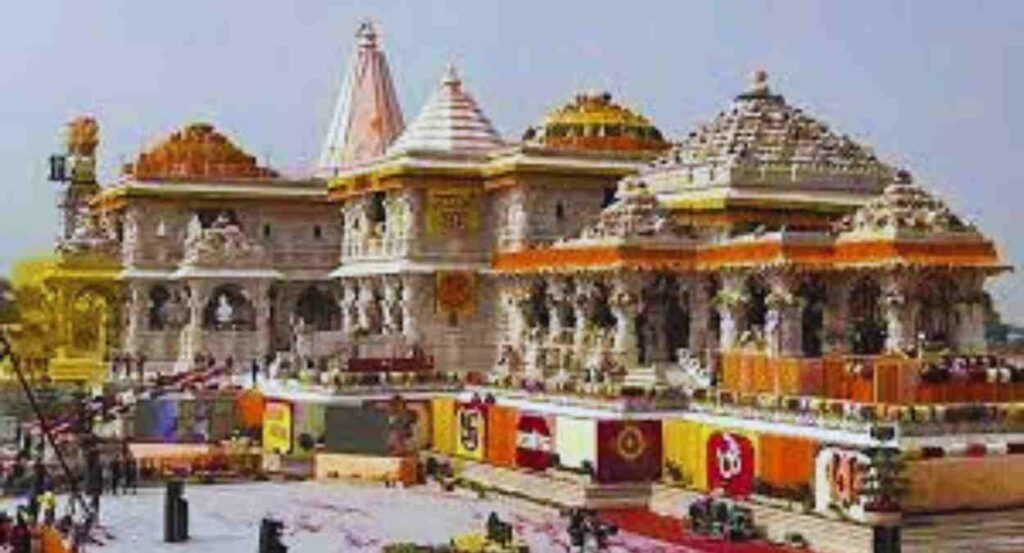
Detailed Timeline of the 134-Year-Long Legal Battle For Ram Mandir
The Ayodhya dispute went through a complex, marathon legal journey spanning 134 years across various courts. Let’s trace this history:
1885: Mahant Raghubar Das Files First Case
- Mahant Raghubar Das of Nirmohi Akhara filed a civil suit seeking permission to construct a permanent temple over the Ram Chabutra in the outer courtyard of Babri Masjid.
- The Court denied construction but granted permission for worship at Chabutra.
1989: Deoki Nandan Agarwal Files Case
- Deoki Nandan Agarwal filed a case as the next friend of Ram Lalla Virajman in the Allahabad HC seeking ownership and possession of the disputed site.
1950: Gopal Singh Visharad and Nirmohi Akhara File Cases
- In 1950, two civil suits were filed by Nirmohi Akhara and Gopal Singh Visharad demanding unhindered access to worship at the site.
1959: Nirmohi Akhara Claims Ownership
- In 1959, Nirmohi Akhara filed another case claiming itself to be the custodian of the Janmasthan, seeking possession.
1961: UP Central Sunni Board Files Case
- In 1961, the UP Central Sunni Waqf Board filed a case claiming the site was a historic mosque.
1989: Former Judge Files Case On Behalf of Ram Lalla
- In 1989, former Allahabad High Court judge Deoki Nandan Agarwal filed a case as the ‘next friend’ of Ram Lalla, seeking title rights over the disputed land on behalf of the deity.
2003: UP Central Sunni Board Challenges ASI Excavation
- After the ASI found proof of a temple under Babri Masjid, the Sunni Waqf Board challenged it in the Allahabad HC.
2010: Allahabad HC Delivers Historic Judgment
- In 2010, the Allahabad HC accepted that the Janmasthan was the birthplace of Ram and divided the land into three parts Ram Lalla, Nirmohi Akhara and the Sunni Waqf Board.
2011: SC Stays Implementation of 2010 Allahabad HC Verdict
- In 2011, the Supreme Court suspended the Allahabad HC judgment after both Hindu and Muslim groups challenging it filed appeals.
2019: SC Reserves Final Verdict After 40 Days of Hearings
- The Supreme Court heard all arguments by contesting parties for 40 days and reserved its final verdict.
2019: SC Awards Disputed Land for Temple Construction
- On November 9, 2019, the SC awarded the entire disputed land to the Hindu parties for temple construction and allotted alternate land for a mosque.
This complex timeline finally culminated in the 2019 Supreme Court verdict that enabled a peaceful resolution to this decades-old dispute through a landmark judgment.
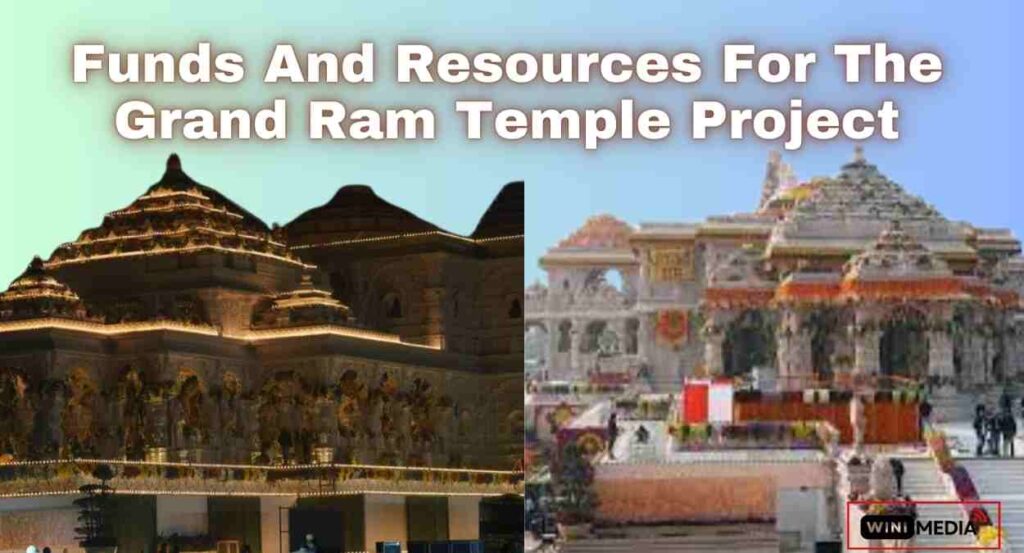
Funds and Resources for the Grand Temple Project
The construction of such an expansive temple complex in Ayodhya needed extensive financial and physical resources:
- Rs 1000 crore was collected as public donations for temple construction within 3 months of the launch of the donation drive.
- The total project cost is estimated to be around Rs 2500 crore out of which 300 crore was allocated by the Uttar Pradesh government.
- Over 300,000 cubic feet of carved sandstone and marble sourced from multiple states were used for the construction.
- Around 6000 tonnes of carved red sandstone for the temple’s inner sanctum was sourced from Mirzapur and Rajasthan.
- Over 130 trucks carrying carved stones arrive at the temple site every day from across India.
- Around 17,000 copper sheets for covering temple roofs have been donated by devotees.
- 4 lakh cubic feet of carved pink sandstone for the temple facade was sourced from Bansi Paharpur.
- Over 50,000 sq ft of Makrana marble has also been used in construction.
- 250 eminent sculptors worked day and night with advanced tools to hand-carve intricate designs on stones.
The Ram Mandir is being built using best-in-class materials sourced from various corners of the country through collective resources and devotee donations.
Boost to Local Economy and Jobs
The mammoth temple construction has provided a major fillip to Ayodhya’s economy and employment generation:
- Over 50,000 workers are involved in ongoing construction work at the temple site. Out of these, many are local labourers.
- MSMEs in Ayodhya have received orders of over Rs 16 crore for the supply of materials like marble, building hardware, pooja items etc.
- There is a huge demand for hundreds of copper artisans from villages in Ayodhya. Their incomes have doubled.
- Real estate demand has boomed, with land prices appreciating 50-60% recently as demand grows.
- Ayodhya will require over 5 lakh additional hotel rooms, generating hospitality jobs.
- The tourism sector in UP’s Awadh region will receive an overall boost.
- Retail markets have sprung up selling religious memorabilia near the temple.
- Even agriculture has prospered as demand for flowers, coconuts, and sweets increases for rituals.
The ongoing progress in the construction of the grand Ram Mandir complex has uplifted Ayodhya’s economy and created innumerable jobs.
Transformational Impact on Ayodhya’s Development
The beautification and infra upgrades around the Ram Janmbhoomi complex are transforming Ayodhya:
- Over Rs 6000 crore worth of infrastructure projects have been announced for Ayodhya including an international airport.
- The UP government has approved the riverfront development of the Saryu River along 84 ghats.
- Widening and upgrading of roads leading to the temple town is underway.
- Ayodhya Railway Station is being revamped and expanded into a world-class transport hub.
- Dredging of the river for enabling barges and steamers has been started.
- Streetscaping of roads, better water supply, drainage, and power lines are in progress across the city.
- The development of ashrams, Dharamshala, hotels, and restaurants is being prioritized.
Ayodhya is being upgraded across parameters including connectivity, amenities and tourism infrastructure to meet its emerging potential. The city is all set to regain its historic prominence as a foremost place of pilgrimage.
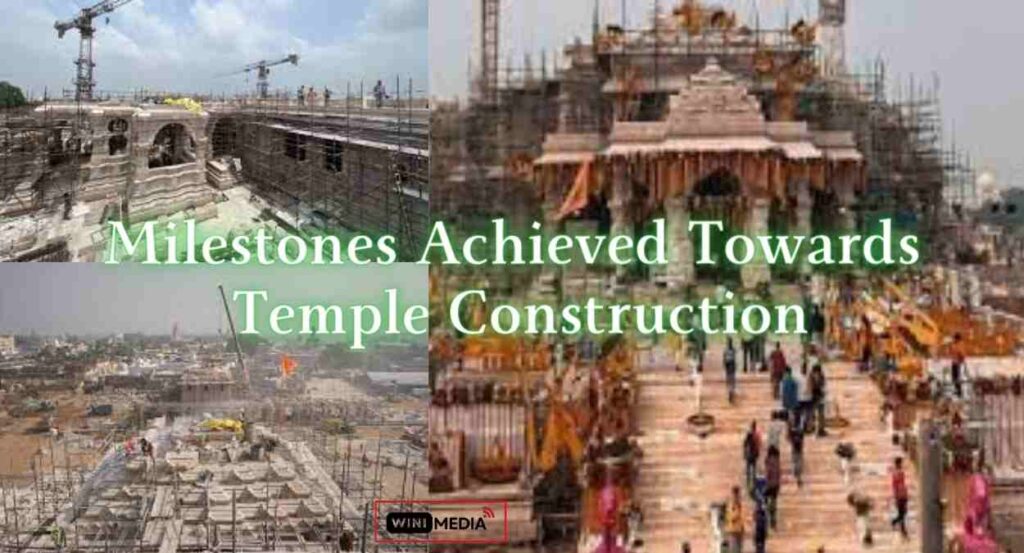
Milestones Achieved Towards Temple Construction
Some key milestones have marked the journey towards achieving the dream of a grand Ayodhya Ram Mandir:
1989: Shilanyas Ceremony by VHP
The Shilanyas or foundation stone laying ceremony was performed at the site in 1989 by the Vishwa Hindu Parishad (VHP), starting construction plans.
2002: Formation of Ram Janambhoomi Nyas
This body was created by the VHP in 2002 to promote and oversee the construction of a Ram temple at the site.
2010: Allahabad High Court Verdict
This verdict acknowledged the disputed land was Ram’s birthplace, representing huge progress for the temple cause.
2015: VHP gathering of Stones
In 2015, stones were gathered through donations from Indian rivers and carved for temple use.
2017: Launch of Shri Ram Janambhoomi Teerth Shetra Trust
This trust was formed to oversee temple construction after the final 2019 SC verdict.
2020: PM Modi Conducts Bhoomi Pujan
On August 5, 2020, PM Modi consecrated the temple site, signalling the formal start of construction.
2022: Completion of Temple First Floor
In January 2022, the first floor of the temple superstructure was completed with the installation of 1.2-tonne carved red sandstone blocks.
2023: Completion of Main Temple Structure
In January 2023, the main temple sanctum and complex was structurally completed, and ready for the idol installation.
2024: Planned Opening to Devotees
After the Pran Pratishtha ceremony on 22 January 2024, The mandir was opened for worshippers from 23 January 2024 and on this every day more than 2 lakh devotees reached Ayodhya to see the cute Ram Lalla
The journey has involved centuries of struggle and perseverance to fulfill the dream of rebuilding the sacred Janmabhoomi site.
Ayodhya Ram Mandir FAQs
Q1. When will the Ram Mandir be complete?
The main temple construction has been completed by early 2024 before opening it for devotees on 23 January 2024 The entire complex development will likely continue beyond 2025.
Q2. How is the Ram Mandir designed?
The Ram Mandir is built in ancient Nagara Hindu temple architecture style using carved sandstone. The temple will be 161 feet tall and 360 feet long and have 3 domes.
Q3. How much did the land cost for Ram Mandir?
The entire 67 acres of land for the temple complex was acquired by the government of India for Rs 600 crore and donated for temple construction.
Q4. How many stones are used in Ram Mandir?
Over 2 lakh cubic feet of carved sandstone and marble sourced from multiple states have been used in constructing the Ram Mandir structure and complex.
Q5. What is the Ram Lalla statue made of?
The Ram Lalla idol is carved out of a single black touchstone rock using advanced sculpting tools. The 51-inch tall statue took over 6 months to carve.
Q6. How deep are the foundations of the Ram Mandir?
The temple’s foundations go 49 feet deep supported on 2,118 pillars buried deep in the ground, with a load-bearing capacity of 13,000 tonnes.
Q7. How many sculptors worked on the Ram Mandir?
Over 200 specialized sculptors were engaged in intricately hand-carving the numerous sandstone blocks used in the temple construction.
Q8. How many visits are expected at Ram Mandir annually?
Over 10 crore devotees are expected to visit the Ram Mandir complex every year once it opens, making it one of the most visited religious sites globally.
Conclusion
The construction of the grand Ram Mandir in Ayodhya after an over century-long battle concludes one of the most emotive and divisive issues in modern Indian history. It has brought joy to millions of Hindus who revere Lord Ram and the Janambhoomi site.
The intricately carved temple will showcase India’s rich cultural heritage and serve pilgrims as a place of immense faith. However, even as Hindus rejoice, the state must ensure that members of all religions feel respected in India’s pluralistic society. Communal peace, just governance and equal rights for all citizens should be the foremost principles now.
As Ram Mandir opens in 2024, let it symbolize the victory not just of faith, but of unity over division and goodwill over discord.
Also Read :
Emotional First Glimpse: Devotees Captivated By Ram Lalla Idol Of Ayodhya Ram Mandir
90-30-50 Diet Plan: A Balanced Nutrition Plan For Your Optimum Health
Affordable Samsung Galaxy A35 Coming Soon with Exynos 1380 Chip And Modern Design

















